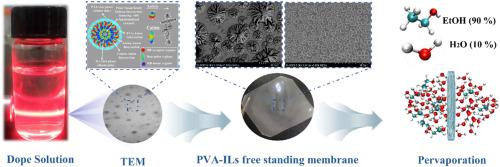自组装的 ILs-PVA 胶束纳米结构赋予渗透蒸发膜极高的乙醇脱水性能
IF 8.4
1区 工程技术
Q1 ENGINEERING, CHEMICAL
引用次数: 0
摘要
要获得具有高选择性和高通量的渗透蒸发(PV)膜,与目标成分实现强相互作用并构建丰富的传输通道至关重要。在此,利用 COSMO-RS 根据生物乙醇脱水的相对选择性和容量目标筛选出三种离子液体(ILs)。离子液体、EtOH 和 H2O 之间的相互作用能分析表明,离子液体能与水形成强氢键,并能破坏 EtOH-H2O 共沸混合物中的氢键,这有利于提高选择性。此外,在多重氢键、静电作用和范德华力的驱动下,ILs 能与聚乙烯醇(PVA)自组装,制造出具有有序胶束纳米结构的光伏膜,其结构已被 MD 模拟所揭示。ILs-PVA 胶束的形成极大地影响了膜的表面形态、粗糙度和水接触角,为膜提供了额外的传输通道。最佳膜(cmc 点)的乙醇脱水分离系数高达 1627,50 °C 时的通量为 684 g/m2h。可以预见,这种新型自组装 ILs-PVA 胶束纳米结构策略将在乙醇-乙酸乙酯、水-丁醇等其他共沸混合物分离过程中找到广阔的应用前景。本文章由计算机程序翻译,如有差异,请以英文原文为准。

Self-assembled ILs-PVA micelle nanostructure impart the pervaporation membrane with high ethanol dehydration performance
Achieving strong interaction with the targeted composition and constructing abundant transport channels is crucial to obtain the pervaporation (PV) membrane with high selectivity and flux. Here, three ionic liquids (ILs) were screened out based on their relative selectivity and capacity targeting for bioethanol dehydration by COSMO-RS. The interaction energies analysis between ILs, EtOH, and H2O suggests that the ILs can form strong hydrogen bonds with water and disrupt the hydrogen bond in the EtOH–H2O azeotropic mixture, which is beneficial for improving the selectivity. Furthermore, driven by the multiple hydrogen bonds, electrostatic interactions, and van der Waals forces, ILs could self-assemble with polyvinyl alcohol (PVA) to fabricate the PV membrane with well-ordered micelle nanostructure, as its structure was revealed by MD simulations. The formation of the ILs-PVA micelle dramatically influenced membrane surface morphology, roughness, and water contact angle, providing an extra transport channel for the membrane. The optimal membrane (at the cmc point) exhibited a superior ethanol dehydration separation factor of 1627, along with a flux of 684 g/m2h at 50 °C. It can be expected that this novel self-assembled ILs-PVA micelle nanostructure strategy will find promising applications in other azeotropic mixture separation processes, like ethanol-ethyl acetate, water-butanol, etc.
求助全文
通过发布文献求助,成功后即可免费获取论文全文。
去求助
来源期刊

Journal of Membrane Science
工程技术-高分子科学
CiteScore
17.10
自引率
17.90%
发文量
1031
审稿时长
2.5 months
期刊介绍:
The Journal of Membrane Science is a publication that focuses on membrane systems and is aimed at academic and industrial chemists, chemical engineers, materials scientists, and membranologists. It publishes original research and reviews on various aspects of membrane transport, membrane formation/structure, fouling, module/process design, and processes/applications. The journal primarily focuses on the structure, function, and performance of non-biological membranes but also includes papers that relate to biological membranes. The Journal of Membrane Science publishes Full Text Papers, State-of-the-Art Reviews, Letters to the Editor, and Perspectives.
 求助内容:
求助内容: 应助结果提醒方式:
应助结果提醒方式:


